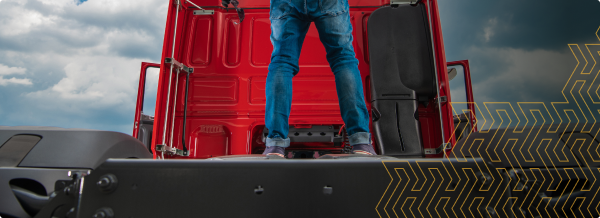
Preventative Maintenance: How to Get the Most Mileage Out of Your Truck

Prevent breakdowns
Download our checklist to learn how to extend the longevity of your rig.
By downloading this guide, you agree to Truckstop’s Terms and Conditions and Privacy Policy.
A regular preventative maintenance plan is one of the most important routines any truck driver can adopt. Taking care of your equipment before problems arise can help extend the longevity of your rig, saving you time, funds, and frustration in the long run.
We have compiled a comprehensive guide to help you maintain your truck and keep it running smoothly. We cover the basics and benefits of a maintenance plan, including regular inspection checklists you can do yourself and instances where it’s best to call a professional. You’ll also find tips and best practices for seasonal maintenance.
Truck Inspection Checklist
While this guide is primarily for carriers, it’s good to know who else is utilizing checklists to inspect your vehicle. Certified Department of Transportation (DOT) officers use a checklist as part of the mandatory annual inspection of your vehicle. Any commercial motor vehicle (CMV) that weighs more than 10,000 pounds is subject to an annual inspection. If you are stopped for a roadside inspection, knowing what inspectors look for helps you stay ahead of the game and avoid any fees or fines.
Authorized parties who can stop a vehicle and perform an inspection include:
- Federal Motor Carrier Safety Administration (FMCSA): The FMCSA oversees and funds most commercial vehicle inspections.
- Commercial Vehicle Safety Alliance (CVSA): The CVSA develops the inspection criteria and program your vehicle is subject to.
- State Troopers: They perform the actual inspection and will have a checklist handy when they pull you over.
Preventative maintenance not only helps you stay safe on the road but also gives you reassurance about any inspections you might be subject to. If you are a fleet manager, requiring your drivers to perform preventative maintenance inspections daily, weekly, monthly, and annually helps lower repair costs, reduce potential insurance claims, and increase your drivers’ safety on the road.

Getting Started on a Preventative Maintenance Plan
Like any new routine, it’s too easy to put off preventative maintenance, especially if you’re not having problems or are in a hurry to get loads moved. Remember: preventative maintenance prevents problems by addressing them early to help avoid bigger, more expensive repairs later on.
Whether you’re a fleet manager or an independent truck driver with a single truck, here are four things you can do to begin your preventative maintenance plan:
- Take note of your vehicle(s). Every vehicle will need its own specific maintenance plan based on how often it is driven, its mileage, its fuel system, and the weather conditions it typically operates in.
- Prepare a schedule. While there are many suggested types and frequencies of preventative maintenance you should perform, it’s best to establish a customized calendar for each vehicle to keep track of when each inspection is due.
- Train your drivers. Fleet managers are responsible for training drivers on preventive maintenance and informing them of the maintenance schedule for their vehicles. Creating clear expectations and communication plans will make this process smoother.
- Document every maintenance routine. Each individual truck should have documentation of all maintenance performed. Record when checks are performed and any repairs or changes, such as new tires.

Keeping Maintenance Simple: The Basics
The most important reasons to perform preventive maintenance are to extend your vehicle’s lifespan, reduce maintenance costs, and improve safety for you and other drivers. By keeping your truck in top condition, you can also improve your truck’s efficiency, resulting in increased profitability. A truck that is maintained and checked over frequently is, effectively, a “money-making machine.”
But more importantly, preventative maintenance keeps you and others safe. Finding loose bolts, broken belts, or rusty pieces before they break or malfunction can help prevent accidents that could endanger you and other drivers on the road.
Here are the components of a semi-truck that require routine checks and maintenance:
- Brakes. Brakes can deteriorate rapidly with use, so conduct a comprehensive brake check before every trip.
- Tires. While tries are replaced regularly according to wear, it’s still important to give them a once-over before setting out on the road.
- Fluids. Double-check everything from oil and coolant to antifreeze and fuel.
- Electrical. Electrical components are all over your vehicle. Your lights and flashers are essential, so check that all wires are tightly connected and functional.
You can save several cents a mile just by performing basic maintenance before starting your drive. Place this semi-truck preventative maintenance checklist somewhere handy and check every item before beginning your next trip.
Daily Inspection Checklist
Pre-trip inspections before each haul might seem redundant and tedious, but they can prevent costly repairs and breakdowns. These inspections give you the opportunity to check for any abnormalities, loose parts, or essential components that are faulty or could malfunction.
But beyond providing peace of mind, pre-trip inspections are required. The Federal Motor Carrier Safety Administration (FMCSA) requires all drivers to complete routine checks prior to every trip and note any deficiencies or possible concerns. This not only helps keep drivers safe but also keeps you compliant with federal regulations. The great news is that a daily inspection of your truck shouldn’t take more than 15 to 30 minutes.
Make sure you perform these inspections before every drive:
- Walk-around inspection. Perform an exterior and interior visual check.
- Tire inspection. Look for proper tire pressure, tread depth, and any concerning signs of wear or punctures.
- Engine inspection. Check oil levels, coolant levels, and any other fluids. Give everything a once-over, including the radiator, air compressor, steering gearbox, steering linkage, water pump, alternator, belts, hoses, and wiring.
- Fuel tank and battery. Inspect for cracks and leaks in your fuel tank, and ensure your battery levels are normal.
- Brake system inspection. Before you set out on your journey, brake pads, lines, and fluids need a once-over.
- Fluids. Fuel, oil, coolant, power steering fluid, brake fluid, and windshield washer fluid should all be checked before every trip.

Weekly Inspection Checklist
Choose a dedicated day of the week to be your weekly maintenance check day. Weekly inspections are more in-depth than the daily checklist and happen frequently enough to catch anything before it becomes a major issue or safety hazard.
Create a routine around this day so you don’t forget to check the following:
- Visual inspection. Windows, side mirrors, steps, lights, doors, reflectors, and license plates should all be in good working order and clean.
- Engine compartment. Check all engine components, oil levels, heating, and cooling systems.
- Lights and signals. Headlights, high beams, brake lights, hazards, and turn signals should all have a check. You’ll likely need a partner to complete this section.
- Brake system. As always, check your parking brake, brake pads, fluid, and hose.
- Cab interior. Seatbelts, horn, windshield and wipers, airbags, defroster, controls, and gauges. Make sure everything is in working order and tidy to make your job easier and more comfortable.
- Trailer. Frame, shock absorber, brake chamber and lining, mud flap, slack adjuster, and push rod.
- Coupling system. A system failure here could result in a lost load and cause a serious accident. Pay special attention to your kingpin and the sliding fifth-wheel locking pin, then be sure to check: air lines, apron, electrical connections, gap, glad hands, locking jaws, mounting bolt, platform, release arm, and the skid plate.
- Tires. Be sure to examine axle seals, rims and lug nuts, tire inflation, and air pressure.
- Wheel lug nuts. No matter how new your vehicle is, you should always check the lug nuts. Tighten any loose wheel fasteners and look for rust, as it could be a sign that the bolt hole is widening.
- Documentation. Be sure all your paperwork is clean, in good condition, and up-to-date. This includes CDL license, cargo manifest, daily logs, and your medical examination card.
- Emergency kit. Make sure your emergency kit is complete and ready to go. Trucks are required to carry an emergency kit that includes: fire extinguishers ready for use, one spare fuse for each type of fuse needed, warning devices for vehicles (like bidirectional reflective triangles), and red warning flags.

Monthly Inspection Checklist
At least once a month, you should perform a more thorough inspection of your semi-truck. Take this time to make sure the truck’s major systems are operating correctly. Here are five things to inspect:
- More in-depth inspection of the brake system. This will include drums and rotors.
- Cooling system check: Radiator, coolant level, hoses, and belts need a once-over.
- Exhaust system check: Look for any leaks or damage.
- Transmission check: Fluid levels, leaks, and functionality.
- DOT truck inspection checklist: Become familiar with what the Department of Transportation (DOT) expects you to look over every month.
Bi-annual Inspection Checklist
Truck drivers should conduct a thorough, in-depth inspection of their vehicles annually. This comprehensive check goes beyond the basics to ensure that the vehicle will easily pass a roadside inspection.
Here’s what to do:
- Comprehensive vehicle inspection. Check every system over in detail.
- Inspection of safety equipment. Make sure you have working fire extinguishers, first aid kits, and safety belts.
- Verification of required documentation. Your vehicle registration, insurance, and inspection documents should all be up-to-date.
- Special attention to parts subject to wear and tear. This includes windshield wipers, tires, and brake pads.
- Review DOT transportation compliance requirements for carriers.

Preventive Checklist for Seasonal Maintenance
Truck drivers know they can’t expect clear blue skies every day. While maintaining your vehicle is important year-round, there are specific items to consider when preparing for seasonal changes and inclement weather.
Preparing for winter weather well before snow falls can save you time, frustration, and money. You want to feel confident in your safety, and taking time to prepare for seasonal weather can help prevent accidents and keep you from having to make reactive maintenance decisions on the road.
Here’s what to inspect just before winter begins:
- Check your windshield. Look for chips or cracks and ensure your wiper blades and defrosters are working properly.
- Braking system. Be sure your ABS is working properly. Drum brakes can freeze overnight if it gets cold enough, so be sure you pull your truck forward every morning to check.
- Fluids. Check fluids daily to be sure they are at the correct level.
- Tires. Measure your tread depth for more safety on icy roads. A minimum of 4/32 of an inch on steer tires and 2/32 of an inch on all other tires. It’s also important to make sure you have chains ready in case you need them.
- Exterior. Visit a truck wash regularly to keep corrosive road salt from damaging mechanical components, parts, and your truck’s frame.
Challenging driving conditions aren’t limited to the winter months. Drivers also need to prepare for traveling in excessive heat.
Before summer arrives, check the following:
- Air conditioning. Check for leaks and debris buildup.
- Coolant. Drain, flush, and pressure test at least once a year.
- Electrical system. Check the battery for corrosion and ensure all wires are secure.
- Tire pressure. Warm air can raise the air pressure of tires over safe limits.

When to Schedule Professional Inspections and Maintenance
While you can handle many of your inspections, it’s also important to have a professional mechanic or service center perform regular inspections. Another set of professional eyes can help keep you safe and prevent unforeseen issues.
Schedule an appointment with a professional if you encounter any of the following:
- Unusual noises from the engine. Listen for knocking sounds, as they can signal worn-out bearings.
- Body rolling. If your truck is rolling or swaying, get it tested as soon as possible.
- Doesn’t start easily. The sooner you get this issue fixed, the better. It could mean your starter is reaching the end of its life.
- Leaking fluids. Don’t ignore puddles under your vehicle. Leaks can indicate issues with engine oil, coolant, brake fluid, or other vital fluids.
- Excessive exhaust. This could mean the fuel injection system is struggling, oil deposits are in the exhaust manifold, or the air filter or cooling system is clogged.
- Slow brake response. Slow brake response in a truck demands immediate professional attention. It could be due to air in the brake lines, worn pads, or a failing master cylinder, all of which are a concern for safe driving.
- Difficult steering. Your power steering system might need a once-over and this should not be overlooked. Steering difficulty could point to serious issues like power steering failure, loose components, or worn tires, jeopardizing control of the vehicle.
- Check when the engine light is flashing. There are many reasons for this, so visit a maintenance professional for diagnosis and repair.
Why Regular Maintenance Is Essential
You’ll never regret performing frequent, consistent preventative maintenance. Regular maintenance isn’t an expense, it’s an investment. Your truck is your livelihood, and taking the proper measures contributes to the overall safety and longevity of your truck—and your career.
With a proactive maintenance plan, you’re setting yourself up for:
- Fewer unexpected breakdowns
- Fewer accidents
- Reduced operating costs
- Increased customer satisfaction
- Meeting commercial regulations
- Reduced insurance cost
- Increased driver safety
- Greater passenger safety
- Extended vehicle lifespan
- Improved fuel consumption
- Reduced vehicle downtime
Plus, in the case of an on-road emergency, your preventative maintenance checklist can help you diagnose the issue quickly and confidently.

Start a Preventative Maintenance Plan Today
Implementing a preventative maintenance plan and consulting a checklist will not only help decrease your business’s operating costs but also give you confidence that your vehicle is safe and efficient every time you hit the road. Keeping a maintenance checklist handy will help ensure you don’t forget anything, stay compliant with regulations, and pass inspections with ease.
What are you waiting for?
Make more money starting now.
Prevent breakdowns, save money, and extend your truck’s life.
Get the comprehensive preventative maintenance checklist.
By downloading this guide you, agree to Truckstop’s Terms and Conditions and Privacy Policy.
